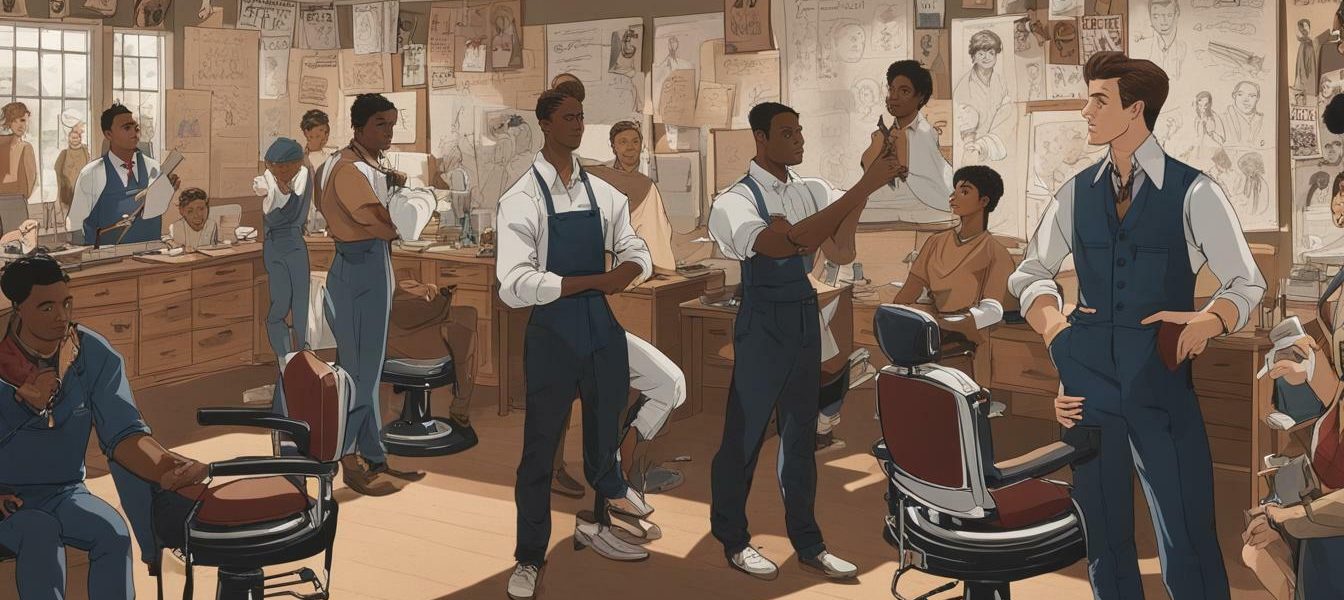
How Long Does Barber School Take?
Are you considering a career in barbering but wondering how much time it will take to complete your training? The answer to that question depends on a variety of factors, including the state where you plan to work and whether you choose full-time or part-time enrollment. In this article, we will explore the timeline of barber school training and the factors that impact its duration.
Key Takeaways:
- Barber school duration can vary based on several factors including state licensing requirements.
- Full-time and part-time enrollment options can impact barber school length of training.
- Barber school graduation requirements typically include a minimum number of hours and practical experience.
Factors Influencing Barber School Duration
Barber school programs can vary in length, ranging from several months to a year or more. The average time for completing a barber school program is typically around 12 months, but this can be influenced by several factors.
Full-Time or Part-Time Enrollment
The duration of barber school can be affected by the student’s enrollment status, whether they choose to attend full-time or part-time. Full-time students typically complete the program in less time than part-time students, as they are able to devote more hours each week to their training. Part-time students may have other commitments, such as work or family responsibilities, that limit the amount of time they can spend on coursework and practical training.
Curriculum Requirements
The length of barber school can also be impacted by the program’s curriculum requirements. Some programs may require more hours of training or focus on specialized skills, which can extend the duration of the program. Students should research potential barber school programs to ensure they align with their personal and professional goals.
State Licensing Regulations
The licensing requirements for becoming a barber can vary by state, which can also impact the length of time it takes to complete barber school. Some states may require more training hours or additional exams, while others may have fewer requirements. Students should research the licensing requirements in their state of residence to determine the specific duration of training needed for their career goals.
The Barber School Curriculum
The curriculum of barber school is designed to provide comprehensive training in all areas of the profession. Students will receive theoretical knowledge and practical experience in various subjects, including:
| Subject | Description |
|---|---|
| Basic Haircutting Techniques | Understanding different hair types, and the fundamental techniques used to create various haircuts. |
| Chemical Services | Understanding the chemical processes used to change hair color and texture, including coloring, highlights, and perms. |
| Facial Hair Grooming | Understanding how to groom beards, mustaches, and other facial hair styles. |
| Sanitation and Safety | Understanding the proper sanitation and safety guidelines to prevent the spread of infections and prevent accidents in the barbershop. |
The length of time it takes to complete barber school largely depends on the number of hours of instruction required by state regulations. The typical length of training for a full-time student is between 9 months to 1 year, but part-time programs can be longer.
Most barber school programs require a minimum of 1,000 hours of instruction, but some states may require more. The program is divided into classroom instruction and hands-on training, with students learning the theory of each subject before practicing their skills on real clients under the supervision of an experienced instructor. Typically, students will complete the theoretical portion of the curriculum before moving on to hands-on training.
Full-Time vs. Part-Time Barber School Programs
When it comes to deciding between full-time and part-time enrollment in barber school, there are several factors to consider. Full-time programs typically take around 10 to 12 months to complete, while part-time programs can take up to two years or more.
The advantage of full-time enrollment is the ability to complete the program quickly and enter the workforce sooner. It also ensures a consistent schedule of hands-on training and classroom instruction, which can be beneficial for students who want to fully immerse themselves in the program. On the other hand, part-time enrollment allows students to balance their education with other commitments such as work or family. It offers more flexibility in scheduling and may be a better option for those who need to continue working while completing their training.
It’s important to note that the duration of the program may vary depending on the school and state licensing regulations. Some programs may require a specific number of hours for each week of study, while others may offer more flexible scheduling options. It’s important to research and compare different programs to find the one that best fits your needs.
Pros and Cons of Full-Time Enrollment
| Pros | Cons |
|---|---|
|
|
Pros and Cons of Part-Time Enrollment
| Pros | Cons |
|---|---|
|
|
Ultimately, the decision to enroll in full-time or part-time barber school will depend on individual preferences and circumstances. It’s important to weigh the pros and cons of each option and choose the one that best suits your needs.
State Licensing Requirements
The duration of barber school can be affected by the licensing requirements of the state where you plan to work. Each state has its own set of regulations regarding the hours of training, practical experience, and examinations needed to become a licensed barber. Some states may require additional hours of training or experience beyond what is offered in a standard barber school program.
For example, in California, the required hours of training for a barber’s license are 1,500, while in New York it is 1,000 hours. In addition to completing these hours, you may also need to pass a written and practical exam to obtain your license.
It is essential to research the licensing requirements in your state before enrolling in a barber school program. This can help you plan and prepare for the additional time and effort that may be required to obtain your license.
Additional Training Opportunities
Barber school programs are designed to provide comprehensive training to students, but there are also additional training opportunities available to those who would like to further enhance their skills. These opportunities can affect the overall duration of training.
One option is an apprenticeship, which allows students to train with a licensed barber in a real-world setting. Apprenticeships typically last between 12 and 24 months, depending on the state, and can provide valuable experience and mentorship.
Continuing education courses are also available for those who would like to specialize in a particular area of barbering, such as shaving or hair coloring. These courses can vary in length, from a few days to several weeks or months.
Advanced training options, such as cosmetology school or barber instructor training, are also available for those who would like to advance their careers in the industry. These programs can take anywhere from several months to two years to complete.
Balancing Barber School with Other Commitments
Barber school demands time and effort, and it can be challenging to balance these commitments with other responsibilities such as family, work, or personal time. Here are some tips to help you navigate these competing demands and manage your time efficiently.
- Set Realistic Goals: Evaluate your current schedule and determine how much time you can realistically devote to barber school. Consider your other commitments and plan accordingly.
- Create a Schedule: Once you have determined how much time you have available, create a schedule that allocates time for each of your commitments. Block off study time, class time and other activities to ensure you remain on track.
- Stay Organized: Keep track of your schedule and deadlines. Use a planner or online tool to help you stay on top of your tasks and keep track of your progress.
- Communicate with Family and Friends: Let your loved ones know about your schedule and how they can support you. Ask for help with childcare or household responsibilities as needed.
- Take Care of Yourself: Take breaks when you need them and prioritize self-care. Exercise, meditate, and practice stress management techniques to stay mentally and physically healthy.
Remember, everyone’s situation is unique, and there is no one-size-fits-all solution to balancing barber school with other commitments. Focus on your goals, communicate openly, and stay organized as you progress through the program and work towards your dream of becoming a barber.
Barber School Graduation Requirements
Before embarking on a career as a barber, it is important to understand the graduation requirements for barber school programs. These requirements vary depending on the program and state regulations, but there are some general guidelines to keep in mind.
| Minimum Hours of Training | Practical Experience |
|---|---|
| Most barber school programs require a minimum of 1,000 hours of training, although some states may require up to 1,500 hours. | In addition to classroom instruction, students must complete a certain number of hours of practical experience. This typically involves working on clients under the supervision of a licensed instructor. |
It is important to note that these are minimum requirements and some programs may offer additional training opportunities beyond the required hours.
Upon completion of the program, students may be required to pass a written or practical exam to obtain their license to practice as a barber. It is important to research the licensing requirements in your state to ensure you are fully prepared for graduation.
Overall, the graduation requirements of barber school may seem daunting, but with hard work and dedication, they can be achieved. By completing the required hours of training and practical experience, you will be well-prepared to launch a successful career in the field of barbering.
Tips for Efficiently Completing Barber School
Attending barber school is a significant investment in both time and money. To make the most of your experience, we’ve compiled some tips for efficiently completing your training program.
- Develop a study schedule: Balancing work, family, and school can be challenging. Develop a schedule that allows you to prioritize your time effectively. Break down your coursework and create a plan to ensure you complete each task on time.
- Take advantage of hands-on training: Barber school provides a unique opportunity to gain practical skills through hands-on training. To efficiently complete your program, make the most of your time in the classroom and practice your newly acquired skills as much as possible.
- Stay organized: Keep your study materials and notes organized to avoid wasting time searching for information. Keeping your study spaces clean and tidy can also help you maintain focus and increase productivity.
- Stay engaged: Stay engaged in class by participating in discussions, asking questions, and seeking feedback from your instructors. Being an active participant in your education can help you learn more efficiently and retain information better.
- Take care of yourself: Self-care is important while attending barber school. Taking care of your physical and mental health can help you stay focused and energized throughout the program. Make sure to get enough sleep, exercise regularly, and eat a healthy diet.
By following these tips, you can efficiently complete your barber school program and prepare yourself for an exciting career in the industry.
Transitioning from Barber School to the Workforce
Completing barber school is a significant achievement, but it’s just the beginning of your journey towards a successful career in the field. To ensure a smooth transition from barber school to the workforce, it’s essential to be well-prepared and equipped with the right knowledge and skills.
One of the first steps in transitioning from barber school to the workforce is to obtain your state license, which typically requires passing a practical and written exam. It’s crucial to familiarize yourself with the licensing requirements in your state and ensure you meet the necessary criteria.
Once you’ve obtained your license, it’s time to start looking for employment opportunities. Networking can be an effective way to find barbering positions, so be sure to attend industry events, join professional organizations, and build relationships with other barbers in the field.
When starting a new job, it’s essential to be receptive to feedback, willing to learn and adapt to new environments. As you gain experience, you’ll start to develop your own techniques and style, which will help you stand out in a competitive industry.
Continuing education is also critical for success in the barbering profession. By staying up-to-date with the latest trends, techniques, and technologies, you can enhance your skills and build a strong foundation for your career.
Remember that every barber’s success story is different, and working hard and staying motivated can help you achieve your goals. Keep practicing, seeking feedback, and staying open to new opportunities, and you’ll be on your way to a rewarding and fulfilling career in barbering.
Conclusion
Barber school can be a rewarding career choice for those who enjoy working with people and have a passion for hair styling. The duration of barber school programs can vary, depending on several factors, such as state licensing requirements, full-time or part-time enrollment, and curriculum requirements.
To complete barber school efficiently, it is essential to have good time management and study techniques. Students can also take advantage of apprenticeships, continuing education courses, and advanced training options to gain additional skills and experience.
Upon graduation, barbers can find work in a variety of settings, such as barber shops, salons, and spas. However, it is important to keep in mind that licensing examinations and ongoing professional development are necessary for a successful career in the field.
If you are considering barber school, be sure to do your research and understand the requirements and commitments involved. With dedication, hard work, and a love for the craft, barber school can turn your passion into a fulfilling career.



